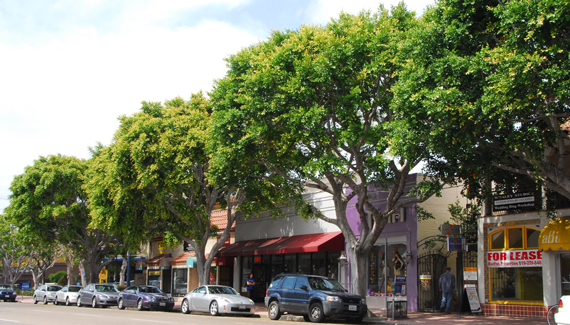|
San Diego’s Trees are Going…Going…
By Anne S. Fege
March/April 2023
 Courtesy Planning Department City Of San Diego
Dr. Fege is a co-founder of Kate Sessions Commitment and chair of the City of San Diego’s Community Forests Advisory Board. She’s an adjunct professor of biology at San Diego State University, and was Forest Supervisor of the Cleveland National Forest in San Diego for 13 years.
Considering the history of shade and ornamental trees in San Diego neighborhoods, it’s clear the numbers are going down—just as we need thousands more in every part of the city.
In older “privileged” neighborhoods (Kensington, Pacific Beach, and La Jolla, for example) that were developed in the 1920s and 1930s, there were large lots for trees. Some developers planted street trees, which were likely watered by tree roots reaching soil water in irrigated front lawns.
In older “redlined” and lower-income neighborhoods (south of the 94 freeway, now the Promise Zone) that were developed in those same decades, the lots were small, the streets were unpaved, and there were no sidewalks or street trees. Today, there are few places to plant trees, as paved parking areas cover many front yards and business districts.
Developments begun in the 1950s included larger commercial spaces, and parking lots were permitted with shade trees, that serve as “de facto” public green spaces. Many of these trees have been dwarfed, topped, or removed over the decades.
In neighborhoods developed since the 1960s, there were Maintenance Assessment Districts (MADs) or Homeowners’ Associations (HOAs) set up to establish and maintain landscapes and trees in boulevards, neighborhood pocket parks, and other areas with public trees.
In recent decades, trees are being lost in older neighborhoods to infill development, with limited tree protection or replacement required by newly approved code changes. Other older trees, such as Torrey pines, have "outgrown" their sidewalk or yard spaces; are uprooted in storms and high winds; die because they aren’t watered deeply (once, each month without rain); or have to be removed because of public safety risks.
This stark loss of trees is one reason I co-founded Kate Sessions Commitment. You’ll remember she planted 100 trees in City Park, now Balboa Park, to help transform it from scruffy, untended land to the jewel of a park it is today. We invite communities to keep large trees healthy, and commit to planting and caring for another 100 trees each year on public and private land. Please join us.
Learn more at katestrees.org.
|
2025
2024
2023
2022
2021
2020
2019
2018
2017
2016
2015
|




